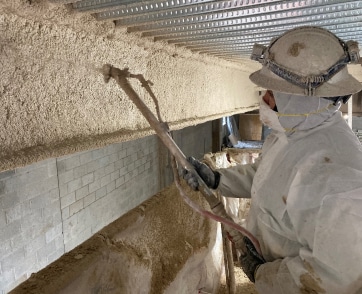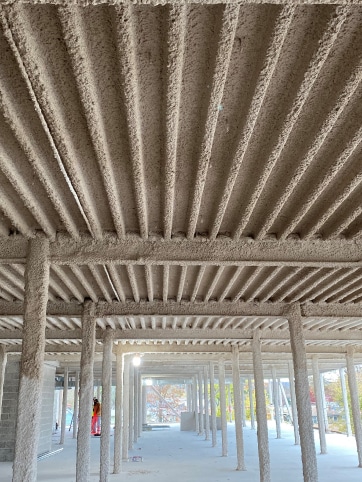Fireproofing products – like cementitious fireproofing – can help you protect your building from fire damage. Just make sure to consider your location and building requirements before using it.

What Is Spray Applied Fireproofing?
Cementitious fireproofing is often referred to as spray applied fireproofing. This coating is either gypsum or Portland cement-based and plays the role of passive fire protection.
Fireproofing contractors will use specialty machinery to mix water and fireproofing and use compressed air to atomize and spray apply the fireproofing to the correct thickness for the required fire rating. When the cementitious material gets completely dry after applying, it forms a barrier that will significantly delay heat transfer and protect building structures in the event of a fire.

Where Is Cementitious Fireproofing Used?
Cementitious fireproofing is the most common form of fireproofing. It can be used in multiple structural types, and there are a variety of products. When choosing which product will be best for your needs, there are a few factors to take into consideration.
Not all cementitious fireproofing is created equal, so you need to choose a product that is best suited for your project as well as the environmental conditions your building will encounter. Some fireproofing is more durable, and some is better suited for high-moisture areas. Some fireproofing products are designed for conditioned spaces while others are tested for durability in freeze-thaw cycles.
While most cementitious fireproofing is installed in areas that are at least semi-protected, there are also products that can be left exposed to the elements.
Types of Cementitious Fireproofing
There are three main categories of cementitious fireproofing, and they each have their own features and benefits.
Standard-Density Fireproofing
The standard-density fireproofing is perfect for properties in areas that are unlikely to suffer harsh environmental conditions or strong weather events. Here are the benefits of using this type of fireproofing:
- Most cost-effective option
- Typically, faster to install.
- Easier to pump greater distances on the jobsite.
Medium-Density Fireproofing
These products are generally Portland cement-based and are therefore more durable. Typically, medium-density fireproofing products have a minimum density of 22 PCF. This product will also generally carry a higher bond strength and therefore will be code compliant with structures over 75ft in height.
The benefits of this type of fireproofing include:- More durable than the lightweight fireproofing.
- More suitable for higher moisture areas.
- Can be used in unconditioned spaces.
- Code compliant for high-rise structures.
Medium-density fireproofing offers durability and thermal performance combined with relatively easy installation. This type of fireproofing is great for parking garages and mechanical rooms. You can use it to meet the construction code requirements for high-rise buildings, as well as those with some exposure to weather.
High-Density Fireproofing
This type of material is best for industrial fireproofing. The manufacturers make high-density cementitious fireproofing from cement-based products with a density around 40 PCF.
Some of the advantages of using this type of material are:- Moisture resistant – provide fire protection in areas with high humidity.
- Hard and durable to resist accidental physical damage.
- Weatherable and able to withstand freezing, thawing and other climatic conditions.
Cementitious Vs. Intumescent Coatings
While dense concrete, cementitious coating, and intumescent coating are all forms of passive fire protection, they are not all created equal. With advances in technology, fireproofing method have progressed to become more effective and also more affordable.
Cementitious and intumescent coatings have markedly different physical and chemical effects. Intumescent coatings expands on structural steel when they come in contact with fire or heat. It increases in volume, which then serves as the barrier between the heat and the building. In extreme heat, intumescent coating combines with oxygen to expand in volume and density – it then serves as an insulated firebreak.
The Bottom Line
Cementitious fireproofing is designed to meet the safety standards of many buildings in a way that’s effective and economical. With the help of this material, you can prevent fire or heat damages to your building – just be sure to choose a product that matches the code requirement and environmental conditions of your structure.
Talk To An Expert